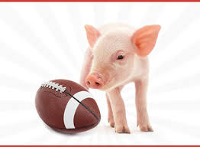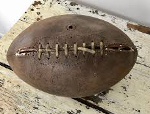|
Why Is a Football Called a Pigskin? The football that American teams and players use today is not made from the skins of pigs. The name "pigskin" for a football is a holdover from the earliest days of the sport. 
Football (referred to as "American football" or "gridiron" in other countries in order to differentiate the American sport from soccer, which is called football in most of the world) originated in the mid-19th Century. At that time, the "ball" wasn't shaped much like a ball or like the version used today because it was actually an animal's bladder. Football teams used bladders of various animals, including pigs. Early on, players decided that "pig's bladder" sounded a bit too realistic and took to using the term "pigskin" (or, more likely, "pig's skin) instead. The players and teams used animal bladders because they were more readily accessible and much less costly than other "balls," which might be made of leather. The act of inflating an animal's bladder, which many people found unpleasant, turned the bladder into a usable shape, something that was essentially round. In order to avoid having to inflate an animal's bladder, people sometimes instead stuffed the bladder with straw or similar materials; the more such non-inflated bladders were handled, however, the more the shape changed. 
In the 1860s, football players and teams began to take advantage of a relatively new invention called vulcanized rubber, which had been invented by Charles Goodyear in the 1840s. Crafting a football out of such a material eliminated the need for an animal's bladder, or "pigskin." But the name stuck. Even today, when footballs are made out of vulcanized rubber (for recreational and youth leagues) and cowhide (for more competitive leagues, like college and the pros), the name "pigskin" isn't far from the lips of observers and commentators, even if "cowhide" would be a more accurate term. Have a suggestion for this feature? Email Dave. |
Social Studies for Kids |





